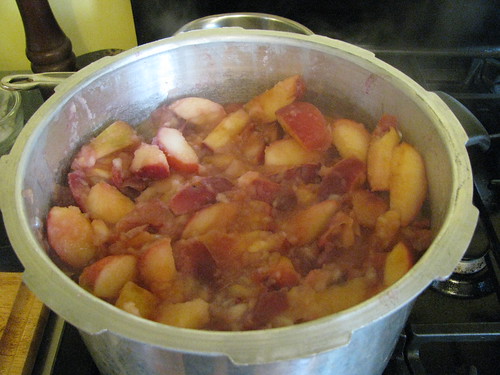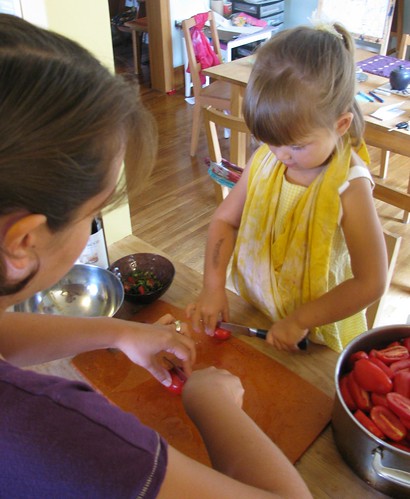 Part of the purpose of Hounds in the Kitchen is to advocate for local foods and local eating. 'Local' is subjective and prone to green-washing as are so many other terms. With the advent of Local Foods Week coming soon (see below), now is a good time to talk about what is local.
Part of the purpose of Hounds in the Kitchen is to advocate for local foods and local eating. 'Local' is subjective and prone to green-washing as are so many other terms. With the advent of Local Foods Week coming soon (see below), now is a good time to talk about what is local.
Some define local in terms of miles: In 2005, authors Alisa Smith and J.B. MacKinnon spent a year eating only what was available growing in a hundred mile area surrounding their home. They chronicled their journey in the bestselling book Plenty: Eating Locally on the 100-Mile Diet, a highly recommended read. They maintain an informative website, 100milediet.org.
The challenge of a 100 mile diet is that many foodstuffs a kitchen relies on are not available year round within 100 miles of every location. Smith and MacKinnon made many a winter meal of the same few ingredients. While they did have access to a wide variety of foods in the US northwest, there are many locations where a 100 mile diet might be so limited as to not give enough variety to maintain optimum health.
Some define local in terms of their city, state, or country. Wanting to challenge ourselves to drink locally, we started the year 2008 with a resolution to only drink spirits, wine, and beer produced in the United States. We chronicled our progress at All American Alcohol (an old blog, posts now transferred here) but abandoned the cause in the spring when we drilled down into the local foods issue. We realized that California wine travels more miles to get to us in Ohio than French wine. Same with the one brand of American made agave spirit produced in California vs. Mexican tequila. We still often choose drinks that do not travel far, but we are no longer limited by geographical boundaries.

Here's our current version of local: Eat foods that come from as close as possible. Make purchases directly from the grower as often as you can to ensure the freshest quality and direct economic impact.
On many days this summer we were able to eat dishes where we grew nearly every ingredient organically in our own backyard. That's local!
We visited pick your own farms to pick large quantities of local in season favorites and preserved them for the winter. PickYourOwn.org is a fantastic resource of places to pick and methods of preservation.
But as autumn comes (first frost warning tonight!), our yard will provide less bounty. We will use our summer preserves and continue to put up fall favorites for enjoyment far into the winter. We will shop the farmers markets to buy direct from Ohio growers as much as is possible. We will continue to purchase eggs and milk directly from a farmer friend. We choose organic produce in the supermarket when Ohio produce is unavailable. LocalHarvest.org is a good source of farmers growing unique commodities across the US and I plan to buy some non-Ohio produce in bulk (like cranberries) from Local Harvest growers this year.
There are several ingredients that we knowingly consume from thousands of miles away. Coffee and bananas, for instance, come from oceans away and are sometimes farmed with environmentally and ethically degrading means. We choose fairly traded, organic versions of these long traveling ingredients and savor them.
When making the decision about what to buy from where, we choose local + organic first, local but not organic next, and organic fair trade but not local third, and if not other choice exists, not local or organic. As much as possible, we apply the same standards to processed food.
During the summer, we eat about 70% local (by ingredients used). That percent declines in the winter or when we are busy.
It took years of changing eating and shopping habits to acheive our current level of local food eating. I plan to write several posts in the future about small steps you can take to change your habits if you are so inclined to eat more locally. I hope you do because local food is often more delicious, healthy, and supportive of the local economy.
----
A few Columbus local food advocates met last week to talk about Local Foods Week. 'What is local' was one of our points of discussion. Lisa the Restaurant Widow has already written a post with the same title. Others may also write their interpretations of local soon and I will link them up here.
----
Local Matters, a central Ohio organization advocating for urban agriculture, local foods in schools, and access to local farm foods, is celebrating local foods with a week of activities for Local Matters Local Foods Week coming up October 3 - 9.

They have an impressive lineup of events, starting with the Market to Market bike ride Saturday the 3rd and concluding with a Finale at the Dublin Whole Foods Market on the 9th. In between you will find benefit dinners, kitchen tours, a school garden tour, and a wine tasting.
Part of the motivation for Local Foods week is to build Local Matter's donation program. They are selling $1 paper Local Matter's sprouts at a variety of locations. If you join their 1000 Friends of Local Matters ($10/month or $120/year) during Local Foods Week, you can receive a special punch card for free Jeni's Ice Cream.
No matter where you are in your journey to eat more locally, education and support is key. Participate in some of the events during Local Matters Local Foods week and you will enjoy the company of other local food lovers. Subsrcibe to the Hounds in the Kitchen feed for year round encouragement to eat locally.









 Go to the farmer's market...Prepare the ingredients...Cook...Eat...Cleanup... Serving fresh local foods can be a time consuming process. With some practice and efficiency, you can eat locally without spending hours a day. Here are some ideas:
Go to the farmer's market...Prepare the ingredients...Cook...Eat...Cleanup... Serving fresh local foods can be a time consuming process. With some practice and efficiency, you can eat locally without spending hours a day. Here are some ideas:


 of yet more
of yet more 






 Part of the purpose of Hounds in the Kitchen is to advocate for local foods and local eating. 'Local' is subjective and prone to green-washing as are so many other terms. With the advent of Local Foods Week coming soon (see below), now is a good time to talk about what is local.
Part of the purpose of Hounds in the Kitchen is to advocate for local foods and local eating. 'Local' is subjective and prone to green-washing as are so many other terms. With the advent of Local Foods Week coming soon (see below), now is a good time to talk about what is local.





 Children aged 3 - 6 years old are invited to join me to explore, cook, and taste local harvest foods this fall. Classes will be held Thursday October 8, 15, 22, and 29 from 11:15 AM - 12 PM at
Children aged 3 - 6 years old are invited to join me to explore, cook, and taste local harvest foods this fall. Classes will be held Thursday October 8, 15, 22, and 29 from 11:15 AM - 12 PM at